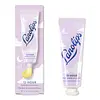What's inside
What's inside
 Key Ingredients
Key Ingredients

 Benefits
Benefits

 Concerns
Concerns

 Ingredients Side-by-side
Ingredients Side-by-side

Lanolin
EmollientCaprylic/Capric Triglyceride
MaskingGlycerin
HumectantCopernicia Cerifera Wax
Ricinus Communis Seed Oil
MaskingPrunus Armeniaca Kernel Oil
MaskingVanillin
MaskingBeeswax
Emulsion StabilisingHoney
HumectantGlyceryl Caprylate
EmollientTocopherol
AntioxidantGlycine Soja Oil
EmollientGlyceryl Undecylenate
EmollientAscorbyl Palmitate
AntioxidantSodium Hyaluronate
HumectantWater
Skin ConditioningCeramide NP
Skin ConditioningTriethylhexanoin
MaskingPhytosteryl/Isostearyl/Cetyl/Stearyl/Behenyl Dimer Dilinoleate
Skin ConditioningDiisostearyl Malate
EmollientBis-Diglyceryl Polyacyladipate-2
EmollientDextrin Palmitate
EmulsifyingDipentaerythrityl Hexahydroxystearate/Hexastearate/Hexarosinate
Skin ConditioningGlyceryl Behenate/Eicosadioate
EmollientGlycerin
HumectantWater
Skin ConditioningSilica Dimethyl Silylate
Emollient1,2-Hexanediol
Skin ConditioningSorbitan Stearate
EmulsifyingCedrol
EmollientDimethicone
EmollientParfum
MaskingGluconolactone
Skin ConditioningHelianthus Annuus Seed Oil
EmollientSucralose
Skin ConditioningProtease
ExfoliatingButylene Glycol
HumectantMadecassoside
AntioxidantSerine
MaskingCholesterol
EmollientHydrogenated Lecithin
EmulsifyingBeta-Carotene
Skin ConditioningDaucus Carota Sativa Root Extract
Skin ConditioningDaucus Carota Sativa Seed Oil
EmollientSqualane
EmollientButyrospermum Parkii Butter
Skin ConditioningGlyceryl Glucoside
HumectantAlcohol Denat.
AntimicrobialPropolis Extract
Skin ConditioningCetearyl Alcohol
EmollientTocopherol
AntioxidantStearic Acid
CleansingHoney Extract
HumectantCodonopsis Lanceolata Root Extract
Skin ConditioningFicus Carica Fruit Extract
HumectantMelissa Officinalis Leaf Extract
Skin ConditioningPunica Granatum Fruit Extract
AntioxidantAcetyl Tetrapeptide-9
Skin ConditioningBeta-Glucan
Skin ConditioningCeramide NP
Skin ConditioningCaprylyl Glycol
EmollientCeramide Ns
Skin ConditioningPhytosphingosine
Skin ConditioningAcetyl Hexapeptide-8
HumectantCeramide AP
Skin ConditioningCeramide As
Skin ConditioningDesamido Collagen
Skin ConditioningCeramide EOP
Skin ConditioningCitronellol
PerfumingGeraniol
PerfumingLinalool
PerfumingCitral
PerfumingTriethylhexanoin, Phytosteryl/Isostearyl/Cetyl/Stearyl/Behenyl Dimer Dilinoleate, Diisostearyl Malate, Bis-Diglyceryl Polyacyladipate-2, Dextrin Palmitate, Dipentaerythrityl Hexahydroxystearate/Hexastearate/Hexarosinate, Glyceryl Behenate/Eicosadioate, Glycerin, Water, Silica Dimethyl Silylate, 1,2-Hexanediol, Sorbitan Stearate, Cedrol, Dimethicone, Parfum, Gluconolactone, Helianthus Annuus Seed Oil, Sucralose, Protease, Butylene Glycol, Madecassoside, Serine, Cholesterol, Hydrogenated Lecithin, Beta-Carotene, Daucus Carota Sativa Root Extract, Daucus Carota Sativa Seed Oil, Squalane, Butyrospermum Parkii Butter, Glyceryl Glucoside, Alcohol Denat., Propolis Extract, Cetearyl Alcohol, Tocopherol, Stearic Acid, Honey Extract, Codonopsis Lanceolata Root Extract, Ficus Carica Fruit Extract, Melissa Officinalis Leaf Extract, Punica Granatum Fruit Extract, Acetyl Tetrapeptide-9, Beta-Glucan, Ceramide NP, Caprylyl Glycol, Ceramide Ns, Phytosphingosine, Acetyl Hexapeptide-8, Ceramide AP, Ceramide As, Desamido Collagen, Ceramide EOP, Citronellol, Geraniol, Linalool, Citral
 Reviews
Reviews

Ingredients Explained
These ingredients are found in both products.
Ingredients higher up in an ingredient list are typically present in a larger amount.
Ceramide NP is a type of ceramide and formally known as ceramide 3.
Ceramides are intercellular lipids naturally found in our skin that bonds dead skin cells together to create a barrier. They are known for their ability to hold water and thus are a great ingredient for dry skin.
Ceramides are an important building block for our skin barrier. A stronger barrier helps the skin look more firm and hydrated. By bolstering the skin ceramides act as a barrier against irritating ingredients. This can help with inflammation as well.
If you would like to eat ceramides, sweet potatoes contain a small amount.
Read more about other common types of ceramides here:
Ceramide AP
Ceramide EOP
Glycerin is already naturally found in your skin. It helps moisturize and protect your skin.
A study from 2016 found glycerin to be more effective as a humectant than AHAs and hyaluronic acid.
As a humectant, it helps the skin stay hydrated by pulling moisture to your skin. The low molecular weight of glycerin allows it to pull moisture into the deeper layers of your skin.
Hydrated skin improves your skin barrier; Your skin barrier helps protect against irritants and bacteria.
Glycerin has also been found to have antimicrobial and antiviral properties. Due to these properties, glycerin is often used in wound and burn treatments.
In cosmetics, glycerin is usually derived from plants such as soybean or palm. However, it can also be sourced from animals, such as tallow or animal fat.
This ingredient is organic, colorless, odorless, and non-toxic.
Glycerin is the name for this ingredient in American English. British English uses Glycerol/Glycerine.
Learn more about GlycerinTocopherol (also known as Vitamin E) is a common antioxidant used to help protect the skin from free-radicals and strengthen the skin barrier. It's also fat soluble - this means our skin is great at absorbing it.
Vitamin E also helps keep your natural skin lipids healthy. Your lipid skin barrier naturally consists of lipids, ceramides, and fatty acids. Vitamin E offers extra protection for your skin’s lipid barrier, keeping your skin healthy and nourished.
Another benefit is a bit of UV protection. Vitamin E helps reduce the damage caused by UVB rays. (It should not replace your sunscreen). Combining it with Vitamin C can decrease sunburned cells and hyperpigmentation after UV exposure.
You might have noticed Vitamin E + C often paired together. This is because it is great at stabilizing Vitamin C. Using the two together helps increase the effectiveness of both ingredients.
There are often claims that Vitamin E can reduce/prevent scarring, but these claims haven't been confirmed by scientific research.
Learn more about TocopherolWater. It's the most common cosmetic ingredient of all. You'll usually see it at the top of ingredient lists, meaning that it makes up the largest part of the product.
So why is it so popular? Water most often acts as a solvent - this means that it helps dissolve other ingredients into the formulation.
You'll also recognize water as that liquid we all need to stay alive. If you see this, drink a glass of water. Stay hydrated!
Learn more about Water